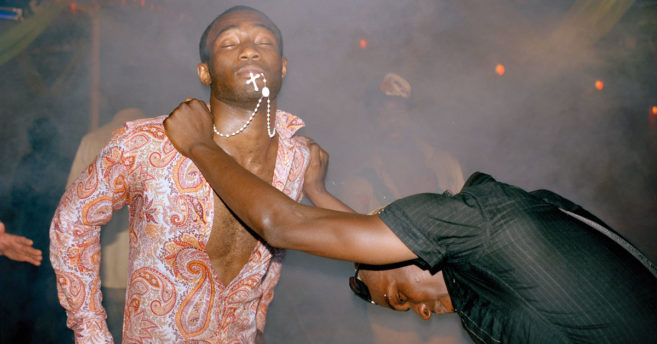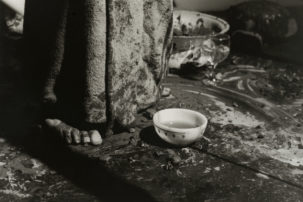For several decades in the 19th century, teams of European explorers desperately criss-crossed the African continent to find the source of the River Nile, a cartographic mystery they felt was of mythological proportions. Ellen Gallagher calls her first Canadian solo exhibition “Nu-Nile” (the name of a hair pomade), suggesting it’s not geographic origins she’s exploring, but rather diasporic cultural memory that lives in the watery depths of art and contemporary society. Throughout her career, the New York– and Rotterdam-based artist has created new forms out of cut, excised, pasted and recombined ephemera from magazines, literature, print and pop culture. These fragments and materials stratify into layered, liquid planes in mediums including collage-based works on paper, painting, installation and film. The exhibition strays from a typical chronological arrangement, instead placing visitors into a set of “circulating nodes” spanning the artist’s decades-long oeuvre.
A work from the ongoing Watery Ecstatic series (2001–) uses what the artist calls a type of whaler’s scrimshaw. Instead of etched designs in ivory or tusk, Gallagher’s incisions into thick white paper raise up the floating outlines of the inhabitants of Drexciya, a fantastical underwater community springing from the bodies of enslaved pregnant women who perished in the Middle Passage. In DeLuxe (2004–5), an exploration of midcentury middle class Black consumerism, Gallagher sculpts Plasticine onto the magazine’s models. Their hairstyles take on organic shapes that gesture outside their gridded arrangement on the wall. In another room, a series of all-black paintings, with their coats of enamel, ink, rubber and paper on linen, create lacquered surfaces punctured by disembodied hair and eyes visible through gaps in the pooled veneer. Bodies hidden in plain sight, such as the denizens of Drexciya and the inhabitants of the pages of Ebony and Our World magazines, follow exhibition visitors as they move from room to room.
Again the modular dissolves into liquid in the monumental Highway Gothic (2017), an installation by Gallagher and Edgar Cleijne that fills an entire gallery with floor-to-ceiling banners of 70 mm film and textile cyanotypes. The architecture of the Interstate 10—a highway that displaced the Black-owned business of Claiborne Avenue in New Orleans—is substituted by a translucent architecture of aquatic species suspended in celluloid. Two simultaneously projected films follow a journey down a flooded terrain, juxtaposing live oak trees with waterlogged concrete columns.
In an upper gallery hang Gallagher’s Sea Bed paintings, their foundations of gridded penmanship paper weighed down by watercolour washes. Beneath four of these works: a normally concealed rectangular window opens a view to an algae-filled pond and the harbourfront, which makes us wonder whether Toronto’s geography could be another node in Gallagher’s archipelagic Black Atlantic.

Edgar Cleijne and Ellen Gallagher, Osedax, 2010. Installation view at the Power Plant, 2018. Courtesy the artists. Photo: Toni Hafkenscheid.

Edgar Cleijne and Ellen Gallagher, Osedax, 2010. Installation view at the Power Plant, 2018. Courtesy the artists. Photo: Toni Hafkenscheid.








